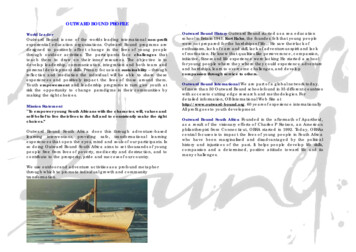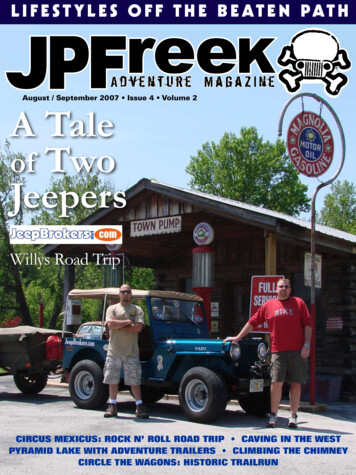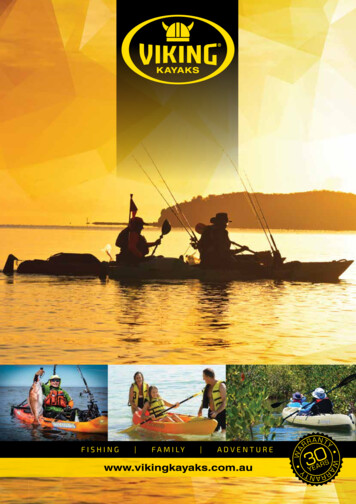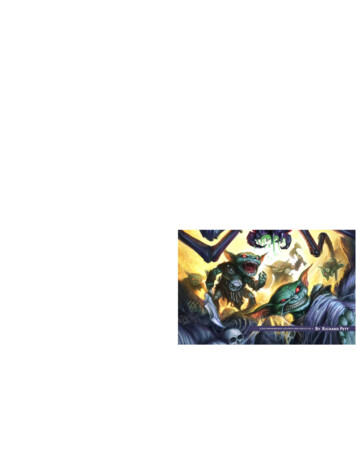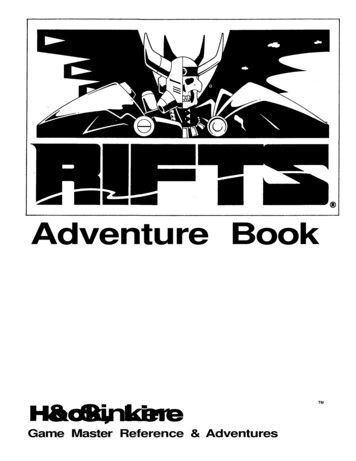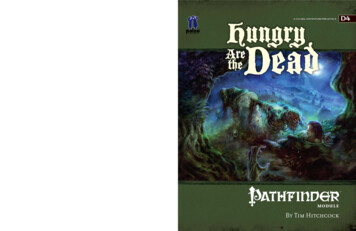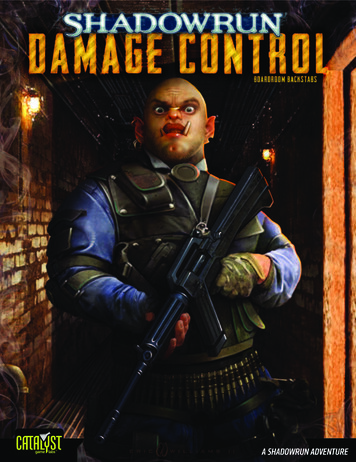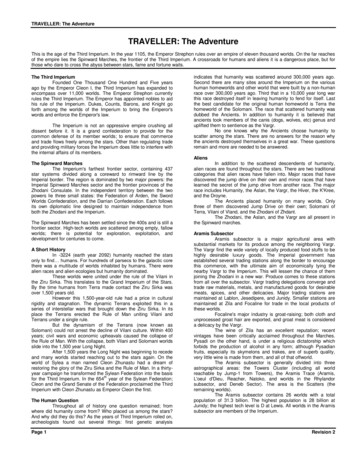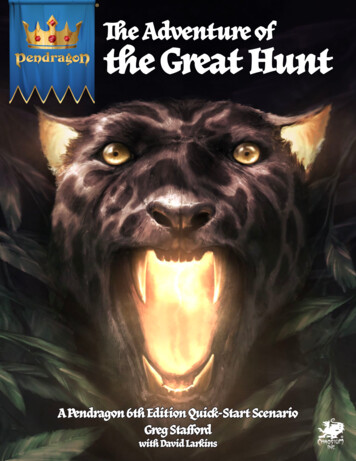
Transcription
The Adventure ofthe Great HuntA Pendragon 6th Edition Quick-Start ScenarioGreg Staffordwith David Larkins
The Adventure of the Great HuntAuthor: Greg Stafford & David LarkinsEditor: David LarkinsLayout: Simeon CogswellCover Artist: Riley SpaldingIllustrations: Kalin Kadiev & Eleonor PiteiraWelcome to this special preview of Pendragon 6th Edition, released on the occasion of WeAreAllUs 2020!WeAreAllUs, observed on the anniversary of Greg Stafford’s passing, is Chaosium’s commemoration of its founderand original creative visionary. This year, we salute Greg’s magnum opus with a sneak peak of the 6th Edition corerules and an accompanying scenario, “The Adventure of the Great Hunt,” originally outlined by Greg way back in1991 and presented here in print for the first time.Greg started work on the new edition ten years ago. Since that time, it has gone through multiple development phasesand is at last nearly ready for its public debut. He called this, and always intended it to be, his “ultimate edition” andwe are proud to see it finally coming to fruition.Veterans will find that the fundamentals of the game remain the same, with subtle modifications reflecting theculmination of nearly three decades’ refinement of Greg’s vision of Arthurian fantasy; many other such changes arefound in the core rulebook, due for release in 2021.For newcomers, welcome! Everything you need to experience the Pendragon system is here: the core rules, a scenarioplayable in a single session, and six pre-generated characters.Let us win glory for our king, who will reward us with honors and lands; and the devil take the hindermost!The Adventure of the Great Hunt 2020 Moon Design Publications. All rights reserved.Pendragon is a registered trademark of Moon Design Publications.Chaosium Inc. and the Chaosium logo are registered trademarks of Chaosium Inc.Pendragon 1985–2020 Moon Design Publications. All rights reserved.Names, characters, places, and incidents featured in this work are the result of an author’s imagination or are used fictitiously. Any resemblanceto actual persons living or dead, events, institutions, or locales, without satiric intent, is coincidental.This material is protected under the copyright laws of the United States of America. Reproduction of this work by any means without writtenpermission of Moon Design Publications and Chaosium Inc., except for the use of short excerpts for the purpose of reviews and the copying ofcharacter sheets and handouts for in-game use, is expressly prohibited.
Pendragon 6th EditionRules Previewhe following sections sum up thecore rules of Pendragon 6th edition.Dice: Use a twenty-sided die (1D20)for resolution, multiple six-sided dice(D6) for damageValue: The level of a Statistic (e.g., Attributes,Skills, Traits, and Passions) is rated between 1 and 20.The higher the value, the better. Situational modifiersmay increase or decrease the value of the Statistic.Glory alwaysincreases; Honor mayincrease or decreaseGlory & HonorThe object of the game is to collect Glory, whichcomes from doing great and notable deeds. Honoris a measure of the character’s integrity, which canrise and fall as they live up to ideals or cut corners forpracticality. A character who loses too much Honor isno longer considered a knight.The following scenario lays out opportunities forGlory awards and Honor loss during the game.Resolution System: UnopposedUse a singletwenty-sided die toresolve all tasks. Used when success is based entirely on the character’sown actions. Roll 1D20 versus the value of the Statistic. If the Statistic value is written as 20 ( x), add theAttributes describevalueof ( x) to the die roll to determine its final value.a character’sphysical make-up. The final number of the die roll is compared to thetarget value to determine the outcome.Traits and Passionscomprise the character’s personality andemotional tenor.Ő Winner: Score a success or critical success, andŐŐŐŐŐAttributesFive Attributes quantify the character’s physicalcharacteristics.Ő Size (SIZ): measures a character’s relative heightŐ Critical Success: Exactly the target value—oftenŐŐŐŐŐconfers an additional benefit beyond a success.Success: Less than the target value.Failure: Higher than the target value.Fumble: A natural 20; a spectacular failurecausing problems.ŐNote that if a target value is 20, it becomesimpossible to fumble, and that a modified dice rollgreater than 20 counts as a result of 20 and is acritical success.Resolution System: OpposedŐUsed when success is contested between two factors.Most combat rolls are opposed. Both opponents roll1D20 versus the relevant Statistic (which is not alwaysthe same between the two) as with unopposed resolution, and then compare their outcomes as follows.a higher final dice roll than the opponent’s. Incombat, this means you hit your enemy.Tie: A success for both opponents that is exactlythe same final dice roll, or both roll a critical success; the situation is unresolved for the moment,but both opponents inflict damage in combat andcheck for weapon breakage as well.Mutual Failure: Both opponents fail; situationis unresolved.Partial Success: Success, but a lower final diceroll than the opponent’s; a minor benefit maybe gained. In combat, you are hit and sufferdamage but may gain protection from a shieldor your weapon.Loser: Failure while the opponent succeeds. Incombat, this means you are hit and suffer damage.Fumble: Spectacular failure, regardless ofopponent’s result. In combat, your weapon isdropped or broken.and weight, compared to others. It is also thethreshold value for determining Knockdown.Dexterity (DEX): measures a character’sagility and nimbleness. DEX keeps a characterupright or horsed.Strength (STR): measures a character’s physicalpower, and their ability to exert force or pressureon an object.Constitution (CON): measures health andvitality. CON is important in determininghow much of a beating you can take, and howquickly you recover.Appeal (APP): measures the character’s naturalcharm, presence, and physical attractiveness.Using Traits and PassionsTraits determine a character’s personality, arrangedin pairs of virtues and flaws, and may affect theiractions. The higher the Trait value, the stronger theexpression of that Trait. Traits over 15 are consideredFamous, and push the character towards acting in amanner consistent with that Trait moreGreat Hunt2
Unopposed Passion ResultsResultUnsung/Normal Passion (1–15)Famous Passion (16–19)Exalted Passion (20 )CriticalInspired 5Impassioned 10Impassioned 10FailureNo resultInspired 5*FumbleMelancholy 1D6 5 days; lose 1point of PassionMelancholy 1D6 5 days; lose 1point of PassionSuccessInspired 5Inspired 5Madness 1D6 5 days; lose 1point of PassionImpassioned 10Madness 1D6 10 days; lose 1point of Passion**An Exalted Passion may be Failed or Fumbled only with a negative modifier.often than not. Traits of 20 or greater are consideredExalted, and cause a character to act in a mannerconsistent with that Trait at all times.Traits may be used to help guide (or dictate) character decisions, to pass a moral test, to provide in-gamehints, or to influence another character. Generalguidelines are provided in the nearby boxed text.Passions are used to give a bonus to Skills or Traits.They may be invoked when the object of the Passionis in danger (or seems to be), or when the characterwishes to act in accordance with the Passion. Forexample, Love (Family) may be used when a memberof the Player-knight’s family is threatened. EachPassion may only be called upon once per day with anunopposed roll, providing a bonus to a single Skillor Trait with the effects lasting until the end of thecurrent situation, or after an hour of time passes.Passion ResultsImpassioned: A temporary 10 bonus to a single Skillor Trait, chosen by the Player. The duration varies,but basically lasts until the situation that evoked thePassion is resolved. For example, in a duel between twoNo Intelligence Rating?No Attributes cover quantifying intelligenceor any form of cleverness or wisdom. Traits andPassions are the measure of human emotions.Attributes represent general knowledge aboutthe body. Skills measure specific and necessarycultural knowledge. Otherwise, characters knowthe minimum they need to function in their cultures and professions. When Player knowledgeis lacking, Gamemasters should take a momentto explain things the character would naturallyknow as a person of their culture, time, and place.knights, the bonus lasts until one is deador surrenders. A Passion bonus may modify a seriesof successive First Aid or Chirurgery rolls resultingfrom a single fight or other source of trauma.Inspired: A temporary 5 bonus to a single Skillor Trait, chosen by the Player, while the situationpersists, as with Impassioned.Melancholy: The character becomes Melancholy.The effects of Melancholy do not strike immediatelyupon failing a Passion roll if the character is activelyengaged in some activity, like fighting in a battle.It takes effect after the activity that caused it iscompleted. A Melancholy character suffers –5 to allSkill, Trait, and Passion rolls. A character who fallsinto Melancholy gains 25 Glory.Madness: The character goes mad and is Outof Play. The Player must turn the character sheetover to the Gamemaster. A character who goes Madgains 100 Glory.Using SkillsSkills are a way of measuring actions that characterscan attempt to do in the game. Actions like eating,walking, and talking are automatic and don’t requireSkill rolls. A roll is needed for Skills because theydescribe actions that hold an inherent chance of failure.A Skill roll is needed when an action is a contest, whenthe character is under strain, is being watched by nobility,is trying to hide something, and so on. No knight or ladyis expected to master all or even most of the possible Skills.Skills are listed alphabetically on the charactersheet in two categories: Skills and Combat Skills. Forthe purposes of these quickstart rules, Gamemastersshould use their best judgment in assessing whichSkills apply to which tasks. Some notes:Ő Attempting First Aid on yourself is done with a–10 Skill modifier.Ő Folklore covers conversing with peasants to gleaninformation as well as remembering bits of lore,Great Hunt3Passions providesignificant bonusesto Traits andSkills, but may alsodrive you mad!
Trait Roll ResultsHorsemanship LimitationModifiers may be applied by the Gamemaster toreflect the demands or pressures of the situation.Normal Traits may be rolled in any order thePlayer wishes. Famous or Exalted Traits mustalways be rolled first, and an unmodified ExaltedTrait never fails.The Horsemanship Skill limits the value of allWeapon Skills employed while riding. No effective Weapon Skill value may be greater than therider’s Horsemanship Skill value, although allCombat Modifiers still apply and may boost thelimited value above the Horsemanship cap.For example, a character with a Sword Skillof 18 and a Horsemanship Skill of 15 fights fromhorseback as if their Sword value is 15. If they gaina 5 height advantage against an opponent on foot,however, their effective Skill is boosted to 20.Ő Critical: The character acts strongly inŐŐŐEach characteror monster mayattempt one actionper Combat Round inaddition to moving.accordance with the Trait. The Gamemastermay grant a relevant 5 modifier to a subsequent Skill or Passion roll.Success: The character acts in accordancewith the Trait.Failure: The Player rolls again, this timefor the Opposing Trait, adjusted by anymodifiers.Fumble: The character acts strongly in accordance with the Opposing Trait. The Gamemaster may grant a relevant 5 modifier to asubsequent Skill or Passion roll.Ő Hafted: applies whenever a knight wieldsŐŐŐŐincluding tales of the fair folk and other strangecreatures of the wild.Hunting is used to pursue quarry and also whennavigating across trackless wilderness, attemptingto cover one’s tracks, or identifying wild animals and plants.Recognize is used for all types of identificationamongst the nobility; from recognizing a singleface at court, to knowing to whom a coat of armsbelongs, to recalling details about family lineagesand enmities.Combat Skills include Battle and Horsemanshipas well as the ten Weapon Skills, which representtraining in broad categories of weapons, some ofwhich are defined here as follows:Ő Charge: applies whenever the knight is mountedŐŐand moving at sufficient speed to execute theMounted Charge action.Sword: covers any steel-bladed weapon with aprotective crossguard and weighted pommel,either with one or two hands.Spear: includes all long-hafted stabbing weaponsintended for use in close combat, wielded withone or two hands.Őmost hafted weapons (axes, maces, hammers)with one hand.Two-Handed Hafted: applies to all haftedweapon types that are normally wielded with twohands—two-handed axes, hammers, and maces,as well as polearms.Brawling: a broad umbrella that applies tofisticuffs, wrestling, using knives, daggers, andother items at close distances, as well as allGrappling attempts.Bow: dictates a character’s aptitude with thebow, a missile weapon usually made of wood orhorn, normally used by peasants for hunting andby foot soldiers in war. Knights normally do notuse bows in combat, although they often usethem for hunting.CombatThe basic time measure for single or small-group combat is the Combat Round. This is a short, elastic unit oftime—basically, the time required to conceive of andperform one action in melee. Combat Rounds continuein succession until everyone is done fighting, eitherthrough incapacitation, death, surrender, or flight.The limit of one action per round means onetype of action, not necessarily one unique physicalmovement, per round. A knight’s entire round ofcombat is not merely a single blow, but an exchangeof attacks and parries, or perhaps maneuvering for anopening before striking a coup de main.The limit of one action per Combat
A character who goes Mad gains 100 Glory. Using Skills Skills are a way of measuring actions that characters can attempt to do in the game. Actions like eating, walking, and talking are automatic and don’t require Skill rolls. A roll is needed for Skills because they describe actions that hold an inherent chance of failure. A Skill roll is needed when an action is a contest, when the .


